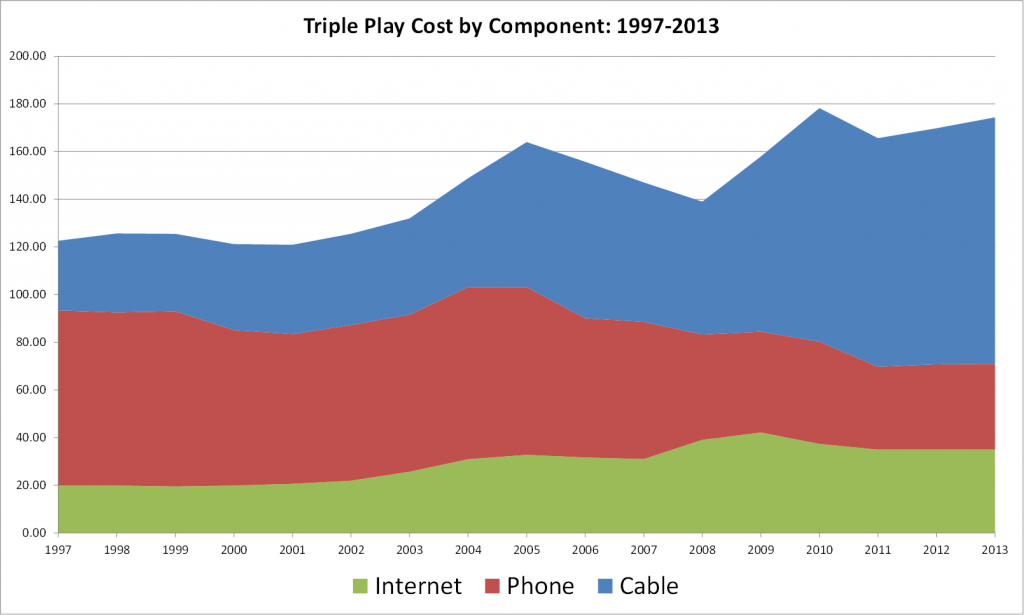As a fun exercise using the magic of Quicken, I created a graph of my triple play cost (phone+cable+internet) since 1997. Even though the data was collected in monthly intervals, I averaged the cost annually to smooth out fluctuations, which were especially prevalent in the phone data pre-2008 when long distance phone calls were still being charged by the minute.
Analyzing the triple play cost
What the data shows us is not a surprise, and I suspect that is indicative of what is happening in most households. The overall cost of the triple play has increased ~50% over the last 15 years from $120/month to $175/month. However, it’s not the total cost of the triple play that’s noteworthy. It’s trends in the individual components that are interesting. Namely,
- The value of landline phone service is declining
The cost of phone service has been cut in half over the last 15 years and will continue to drop, eventually reaching zero. I’m not surprised given that I rarely use my landline. I’m paying $30/month to rent a phone number to give to telemarketers. When I look at my children, who have grown up with a cellphone as their primary means of communication, I doubt any of them will ever pay for landline service in their lifetime, which portends the end of landline service as we know it in the not too distant future. - Advances in internet service have far outpaced the cost
Once could argue that paying $20/month for unreliable 56kbps internet service that was metered by the hour was ridiculously overpriced, but it is the baseline. Compare that to paying $35/month for a pipe that is reliable, is always on and delivers 15Gbps, and it’s clear that internet service is a bargain these days, a HUGE one! Stated more bluntly, the service is infinitely more reliable and over 250,000 times faster. If speed and cost were directly proportional, I should be paying over $5,000,000/month for internet service today. As it stands, internet costs haven’t even doubled over the last 15 years. - Cable’s cost increase doesn’t match it’s value proposition
While the number of channels I receive has increased from 70 to over 600, the number of channels I watch has changed from 10 to about 15. I’m paying over 3x the amount for a service whose value proposition hasn’t changed significantly. If you were to cut off my cable service tomorrow, I might miss watching sports and a few Seinfeld reruns, but other than that, I’m not sure I’d notice. On other hand, if you were to turn off my internet service, I’d be reaching for my checkbook.
What the analysis tells us
- Cord-cutting is not a fad
Disputes over content distribution, like the one that happened between Time-Warner and CBS are becoming more and more common and are continuing to drive up the cost of the cable. People are tired of being held hostage to the cable companies and content providers and aren’t going to tolerate it. The result will be more cord-cutting. You can get by without cable today by using an over the air antenna and internet services like Netflix and Amazon Instant Video, but it’s not quite the same. However, these solutions are improving rapidly, and it’s only a matter of time before cord-cutting catches up to and surpasses the content provided by cable. - The cable business is ripe for disruption
Bundling of content is not a sustainable business model. I don’t want to pay for a service where I don’t use 90% of what is being supplied. If the cable companies do not recognize that their value is in the delivery network and not the bundling of content, they will be marginalized by more innovative and progressive thinking companies like Netflix, Amazon, HBO and YouTube (Google). Cable needs to move to a different model, such as a la carte or on-demand programming, sooner rather than later.
Where we’re headed
I’ve believed for over 10 years that content programming would migrate to an on-demand model. I thought for sure that it would’ve happened by now, but the entrenched players have been slow to move and have used government lobbying to slow down and impede competitive services. History has shown that these tactics only delay the inevitable. The companies that refuse to change are eventually replaced by those that embrace the new business models.
Bottom line, the cable companies and content providers need to start allowing us to choose what we want, when we want it, and only charge us for what we use. Otherwise, we’re going to start letting companies into our living rooms that will.


I haven’t paid for cable in years, and just switched to Republic Wireless for my cellular data. I’d love to see the dip in my graph with these changes!